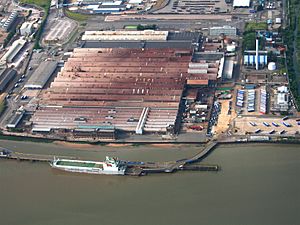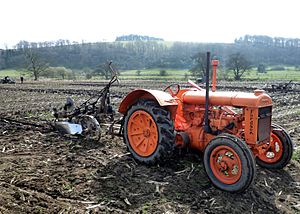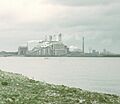Ford Dagenham facts for kids
 |
|
| Operated | 1931–present |
|---|---|
| Location | Dagenham, London, England |
| Coordinates | 51°30′54″N 0°9′11″E / 51.51500°N 0.15306°E |
| Industry | Automotive |
| Products | Engines |
| Employees | 2,000 (approx.) |
| Area | 475 acres (192 ha) |
The Ford Dagenham factory is a very important car-making site in Dagenham, London. It is run by Ford of Britain, which is part of the larger Ford Motor Company. This huge factory opened its doors in 1931. Over the years, it has built an amazing 10,980,368 cars and more than 39,000,000 engines!
The Dagenham plant covers about 475 acres, which is like 360 football fields. Since the year 2000, Ford has invested over £800 million to make it even better.
Even though car assembly stopped here in 2002, Dagenham is still a major production site. It can build 1.4 million engines every year. In 2008, the factory made about 1,050,000 engines. This made it the biggest producer of Ford diesel engines in the world! Today, about 2,000 people work at the Dagenham engine plant.
Contents
Exploring Ford Dagenham's Past
Building the Dagenham Factory (1920s-1945)
Planning for the Dagenham factory started in the early 1920s. Back then, lorries (trucks) were small and roads were not very good. Big supplies like coal and steel were often moved by water transport. So, the Dagenham plant needed to be near deep water. This would allow large ships to deliver materials easily.
In 1924, Ford Motor Company bought land in the Dagenham marshes. It cost them £167,700. This spot was perfect because it could become a deepwater port. This meant much larger ships could bring in supplies compared to the smaller boats used at Ford's old factory.

The Dagenham plant started making Fordson tractors in 1933. Before this, tractors were made in Cork City, Ireland. But when the Irish Free State became independent, the British government added a tax on goods from there. This made it too expensive to make tractors in Ireland for the British market. So, tractor production moved to Dagenham.
On May 17, 1929, Edsel Ford (Henry Ford's son) started the construction by digging the first bit of ground. Building the factory took 28 months. Workers had to drive about 22,000 concrete piles deep into the marshy ground. This was to make sure the huge factory, which included its own steel foundry and power station, would stand strong.
At that time, many countries were trying to protect their own businesses by adding taxes on imported goods. This is called protectionism. Henry Ford wanted his factories in other countries to be able to make most of their own parts. The Dagenham plant was designed to be very self-reliant, even having its own steel foundry and power station. This idea came from Ford's huge Rouge River plant in America.
The very first vehicle made at Dagenham was a Ford AA van in October 1931. The British economy was struggling then, so sales started slowly. But as the economy got better, so did production. By 1937, the plant made 37,000 vehicles.
During the Second World War, the Dagenham plant made many vans and trucks. It also produced special engines and Bren gun carriers (small armored vehicles). Farm vehicles were also very important. At one point, the Fordson tractor made up 95% of all tractors built in the UK.
Growth and Changes (1945-2000)
After the Second World War, Ford's UK factory led the way for the British car industry. Dagenham made popular cars like the Zephyr, Cortina, and Anglia. The 1950s were a time of big growth. A £75 million upgrade finished in 1959 made the factory 50% bigger and doubled how many cars it could make. Ford also bought Briggs Motor Bodies, their main car body supplier, in 1953. This meant car body assembly was now done in-house.
In the 1960s, Ford started to combine its different companies in Britain, Germany, and Ireland. This led to the creation of Ford of Europe in 1967. The new company began to make similar cars in different European factories. By 1970, Dagenham was one of Europe's older car plants. New Ford factories opened in Saarlouis (Germany) in 1970 and Valencia (Spain) in 1976. These new plants also made popular models like the Escort and Fiesta.
This decision to make the same cars in different factories helped Ford. If there were worker disagreements or strikes at one plant, Ford could still make cars at another. This was a big advantage over rivals like British Leyland, who often struggled to deliver cars during strikes. However, making the same cars in different places also showed which factories were more efficient.
In the 1990s, new investments often went to mainland Europe. For example, the Sierra car was made in Dagenham for right-hand drive countries and in Belgium for left-hand drive countries. But in 1990, all Sierra production moved to Belgium. This left the Fiesta as the only car made at Dagenham. The Mondeo, which replaced the Sierra in 1993, was also built in Belgium. However, Dagenham did make two models again for a short time. From 1996 to 2000, it also built the Mazda 121, which was very similar to the Fiesta.
Modern Dagenham (2001-Present)
By 2001, the only Ford car made at Dagenham was the Fiesta. But the main factory for Fiesta production was in Spain. Because car sales were slowing down across Europe, Ford decided not to prepare the Dagenham plant to build the new Fiesta model, which came out in 2002. So, 2002 was the year the last Dagenham-built Ford Fiesta was made.
Ford wanted to show it was still an important company in Britain. So, they focused on making the Dagenham plant even better for building engines. They said this would "help the UK to become the producer of one in every four Ford engines the world over."
Since 2004, the Dagenham site has also been home to the Dagenham wind turbines. These giant turbines help power the factory and local area with clean energy.
In October 2012, Ford announced that the stamping plant (where car parts are pressed out of metal) at Dagenham would close in summer 2013. This meant about 1,000 jobs would be lost. The stamping plant was taken down between 2016 and 2020. Now, a new housing development called Dagenham Green is being built there, with 3,500 homes and a five-acre park.
The original Engine Plant from 1931 and the Dagenham Diesel Centre (DDC) are still very busy. They produce close to 1 million diesel engines every year, which are sent all over the world.
See also
Images for kids



